foreword
RMIT University is a place where the future is very much engrained in the everyday. Our students and researchers curiously explore and imagine, leading the way to the technologies, culture, and cities of tomorrow. This approach is what inspired us to develop the world’s first research centre on the social science of blockchain, what compelled us to address complex problems such as urban sustainability futures, and what enabled us to raise the bar with new approaches to 3D-printing medical implants. This future-oriented approach is also what positioned us to take the lead partnering with other universities, industry, government and the community to support the development of responsible, ethical and inclusive automated decision-making in the ARC Centre of Excellence for Automated Decision Making and Society. RMIT is an innovative environment, from which we collectively dream the future into reality.
Future U is an exhibition composed of equal parts speculative wonder and next generation thinking, and as such resonates deeply with us at RMIT. We are indebted to Dr Evelyn Tsitas and Associate Professor Jonathan Duckworth for bringing this project to us— and for bringing it to life with their curatorial vision. This exhibition helps us imagine how technology will change and how it might change us. Future U levels its gaze on the horizon, looks to what is next and opens for discussion a series of complex questions about who we are and what we might become.
Collectively the works featured in this exhibition explore tomorrow’s world, and how we might connect
with one another in it or be transformed by it. Each of these extraordinary works takes a different approach and proposes different responses. Some are humorous while others are dazzling or provocative. Some are made in studios and others in laboratories. Some works were created in Australia, while others are presented here for the first time. This diversity of perspective and method brings a richness and depth to the discussion. Importantly, but perhaps less evident, is how these works also connect with the present. Their contemporaneity is as indelible as their prescience, for as much as the works provide glimpses into potential futures, they are products of a particular time, which reveal much about the social, technological, and political climate of the day.
We are thrilled that we are able to present Future U at RMIT Gallery. This is a visionary project and, as we emerge from crisis to rethink our future, it is also a timely one. On behalf of the University, I am proud that this exhibition includes works developed by our very own industry-leading creative researchers. On behalf of RMIT Culture, I am excited to see many exquisite works from our collection on display. I would like to thank and congratulate the curators, artists, designers and my team for their work and collaboration. I would also like to acknowledge the Goethe Institut Australien for their generous support of this project.
Paula Toal, Head, Culture and Public Engagement
Page 2
By Associate Professor Jonathan Duckworth and Dr Evelyn Tsitas
07
biographies credits 50 72 79
future
12
future
42
contents are
? are
? Page 3
curators’ essay
future bodies
Karen Casey, Leah Heiss and Emma Luke, Amy Karle, Zhuying Li, Maina-Miriam Munsky and Stelarc
possibilities
Uncanny Valley, Mario Klingemann, Peter Ellis, Christian Mio Loclair, Patricia Piccinini, Alexi Freeman, Bettina von Arnim, Deborah Wargon, Pia Interlandi and Duckworth Hullick Duo
intimacies
Jake Elwes, Libby Heaney and Holly Block
you ready for future u
you ready for the future

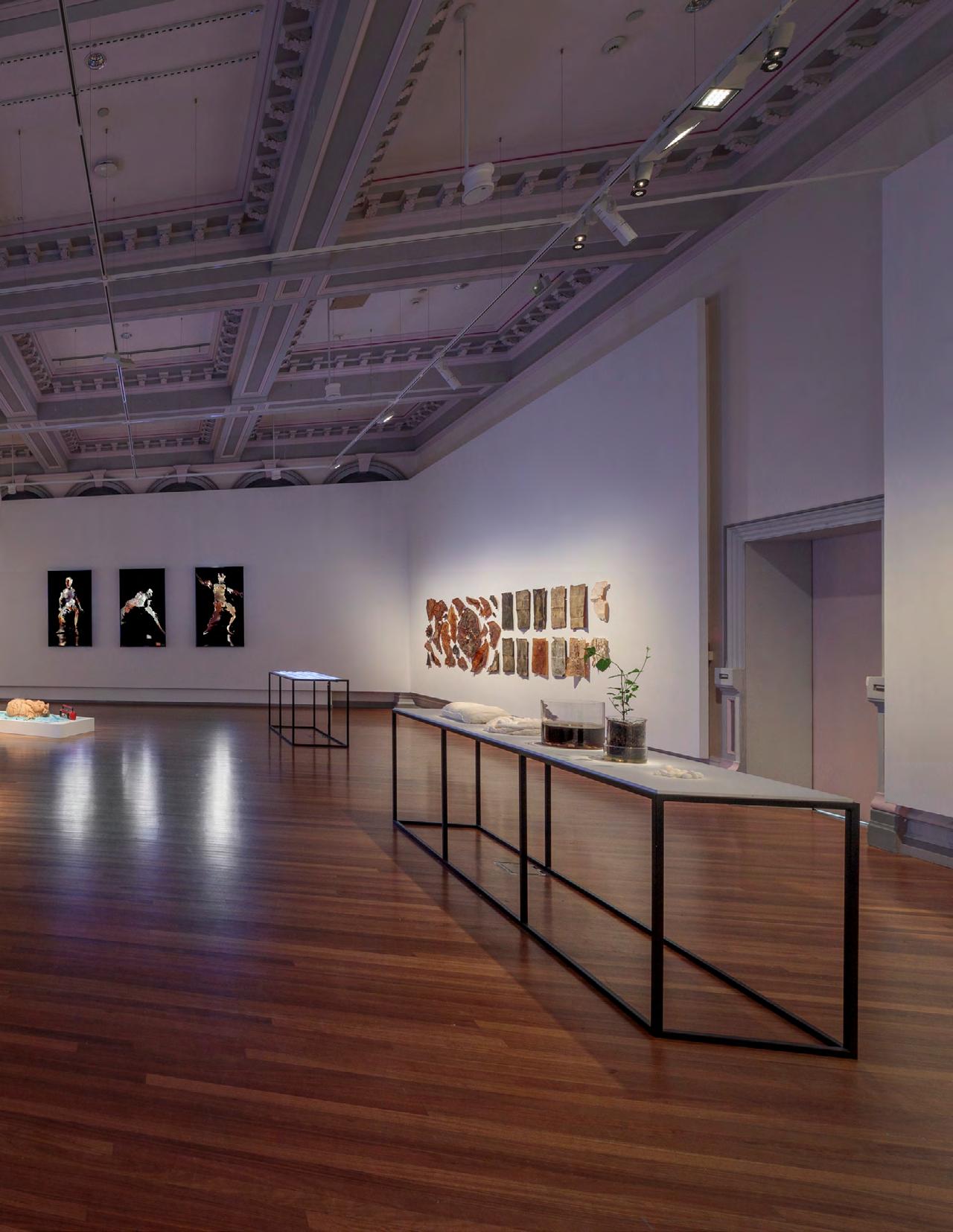
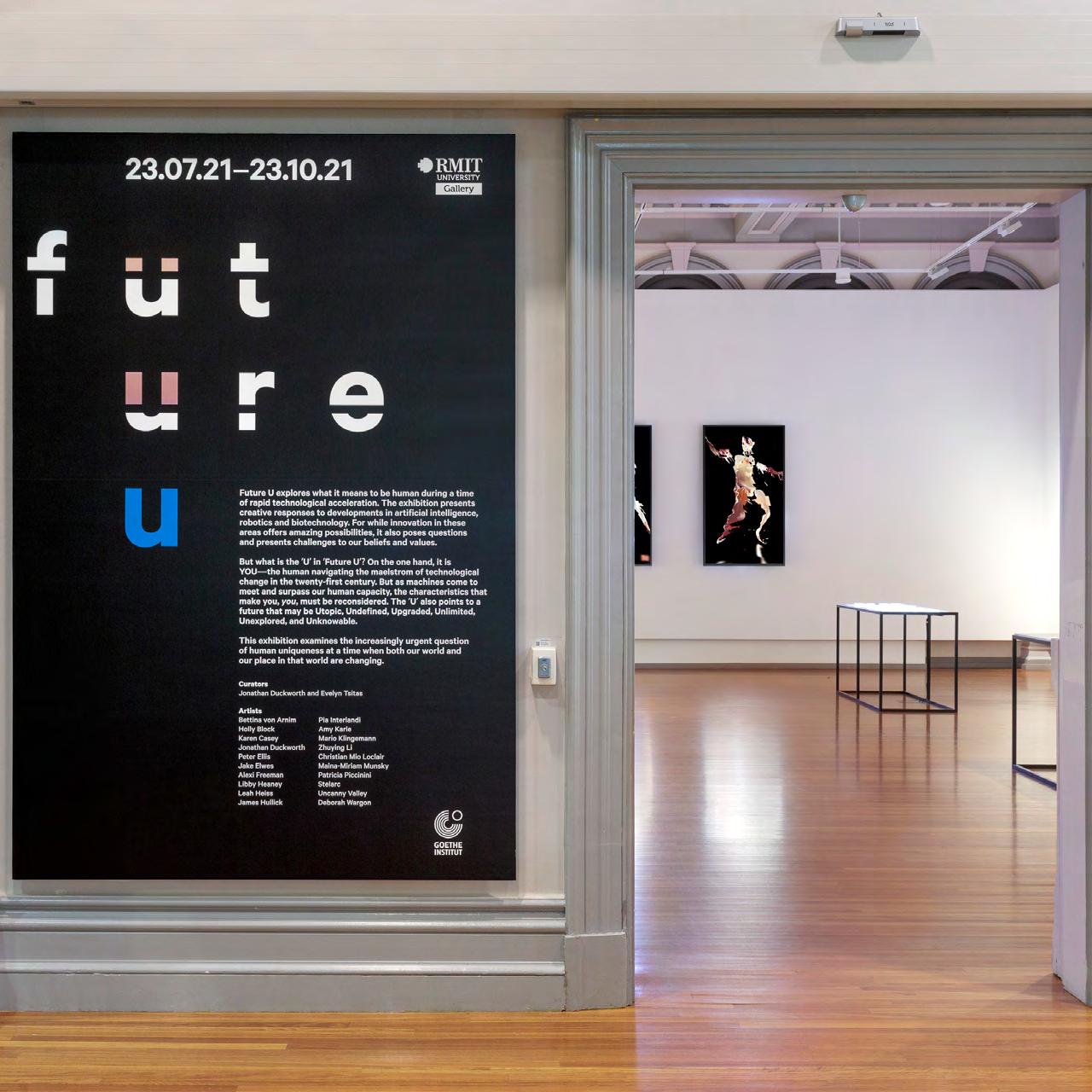
Page 6
Future U explores what it means to be human during a time of rapid technological acceleration and convergence. The exhibition presents creative responses by artists and researchers to the developments in artificial intelligence (AI), robotics and biotechnology that are challenging our deeply held beliefs and values as a species. But while ‘Future’ can be defined as any time after the present, what do we mean by ‘U’?
Curators’ Essay
By Associate Professor Jonathan Duckworth and Dr Evelyn Tsitas
On the one hand, the ‘U’ of Future U is YOU—the human navigating the maelstrom of technological change in the twenty-first century. However, the aspects that make you, you, are increasingly under threat as machines based on AI reveal themselves to be capable of surpassing human capacity. This exhibition examines the increasingly urgent question of what makes humans unique, and how our place in the world may change as a result of accelerated technologies.
Future U also interrogates another ‘U’—a future that may be Utopic, Undefined, Upgraded, Unlimited, Unexplored, and Unknowable. However, if we can be certain about one thing, it is that technological disruption of our presentday human relations and self-identification is, decidedly, Unavoidable.
The aspects that have defined humanity up until now are our unique capacity for language, creativity, emotions, and rational thought. The characteristics of sentience, intelligence, love, empathy, and memory have been privileges long felt to be solely human traits. There is also the fundamentally human urge to transform our bodies, minds, and the world around us. Future U explores these presumptions and urges—it looks at how we are captivated by stories of transformation and fascinated by our very own humanity.
Page 7
On one hand we applaud technology as we harness its power to grant us longer and healthier lives, repair and enhance our broken and failing bodies, and provide us with the ability to have children outside the constraints of conventional reproduction. And yet, we also mistrust technology and fear its capability to take away our usefulness and unique abilities as humans, and our capacity and necessity as workers.
Technologies present us with an existential threat, as it will soon be able to do everything humans can do, just faster, cheaper, and more efficiently. In the past technology threatened to replace manual workers with machines. Moving forward, AI may supersede knowledge and creative workers too. As it permeates every aspect of our interactions with work, with each other, and with ourselves, another U comes into play – the Ubiquitous nature of technology.
In curating this exhibition, we did not seek out artists with a shared vision of the future. We found ourselves drawn to diverse artists whose work grappled with key questions about human endeavour, transformation and relationships. We sought works that opened debate rather than offered answers. We did not fetishise work that looked futuristic or used cutting-edge technologies, acknowledging instead the provocations provided by juxtaposing works created by the human hand or printing press with those generated by computer algorithms. These collective visions of the future are optimistic, dystopic, disruptive, and uncertain, yet filled with possibility. Future U invites us to reconsider our place in our bodies, in relation to others, and in the world surrounding us.
The works in Future U address three main concerns. The first posits that rapid advances in AI, machines, robotics and biotechnologies have disrupted the definition of what it means to be human. Although AI threatens to possess the capacity for independent, creative thought, the works by Mario Klingemann, Uncanny Valley, Christian Mio Loclair, Duckworth Hullick Duo, and Jake Elwes highlight the necessary relationship between the human and technology. The works all rely on algorithms to produce a creative response. However, they also offer
an imprint of the human presence even in the shadow of technological creation. The ‘human in the machine’ is still there, in the lingering or abstracted image and sound of a face, a body, an utterance, or the thoughts and desires of the human programmers. The works have been created using technology, however, each is dependent on the creator’s hand and intention to program the software. They question whether AI programs can be independently creative, or simply provide a facsimile of such generative capacity.
Presenting a different perspective, Deborah Wargon’s intricate four-metre-high hanging paper sculpture explores a human preoccupation with time in our age of AI, when technologies confront us with new possibilities and new uncertainties. Elsewhere, Peter Ellis’ idiosyncratic works on paper can be viewed as a gateway to collective cultural anxiety about technological disruption, with images of biotechnological experiments gone wrong, resulting in monstrous humans, one-eyed rodents, and an alternative evolutionary pathway for giant fleas.
The exhibition’s second premise explores the impact of technologies on our relations with our environments, and with each other. Bettina von Arnim’s 1970s etchings feature humanoid robots consumed by the environments they created. Her dystopian vision of technology seems unsettlingly prophetic in the twenty-first century as we watch digital innovations swallow industries and jobs. Furthermore, today it is widely accepted that humanity has wreaked technological havoc on our environments. The spandex, sparkling stretch fabrics that symbolised the optimism and excitement of 1960s science fiction are not the fabrics of a future we can live in, with textile waste increasingly becoming a major global issue. Instead, Future U highlights the nascent field of biodesign with Alexi Freeman’s bio-textiles that merge life science with industrial design, developing systems to minimise our environmental destruction. With long haul space travel and exploration on the near horizon, there is also a need to consider how we sustainably tread worlds beyond Earth. Pia Interlandi’s funerary garments ritualise natural processes of human growth and decay for future inhabitants on Mars.
Page 8
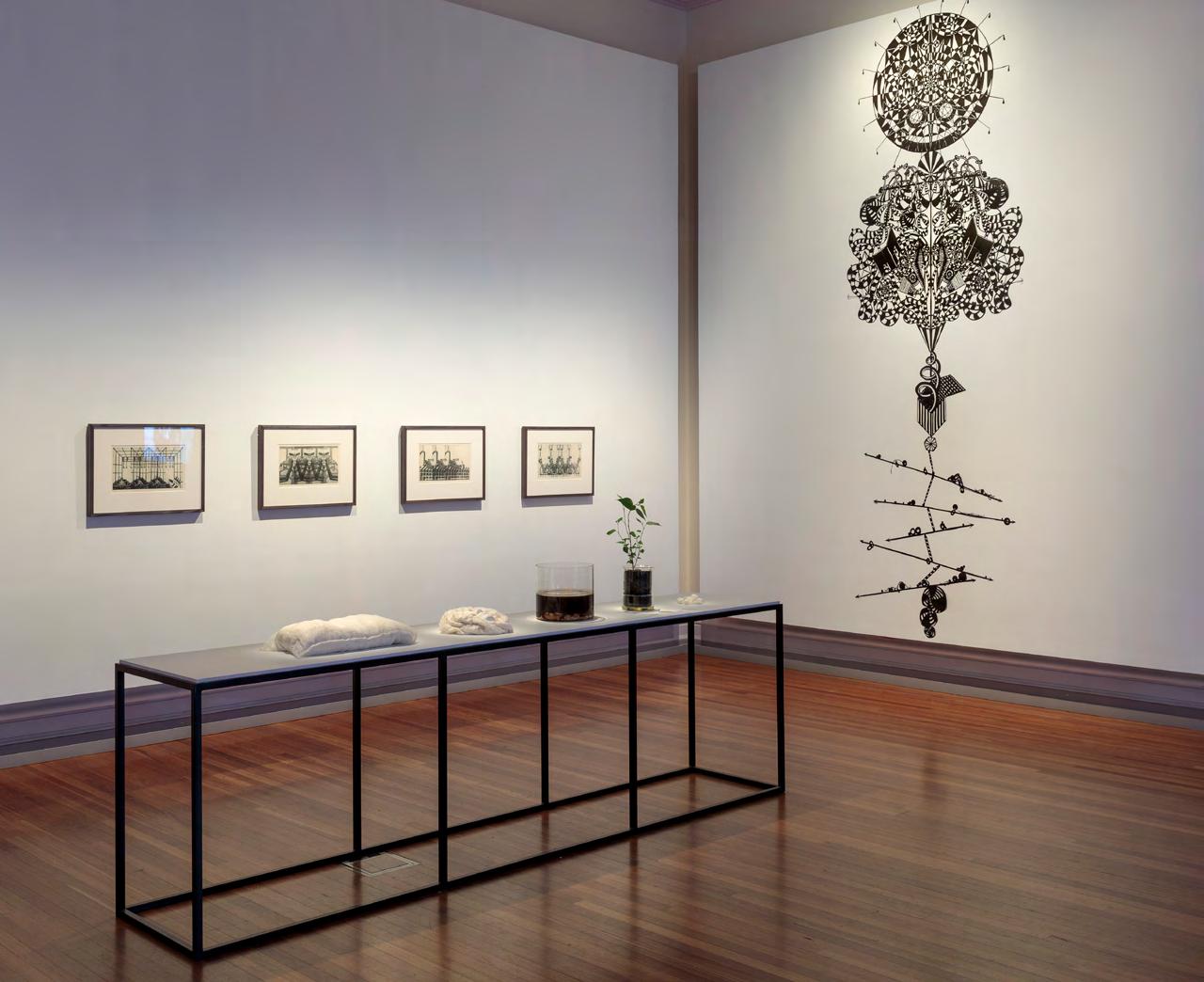
Page 9
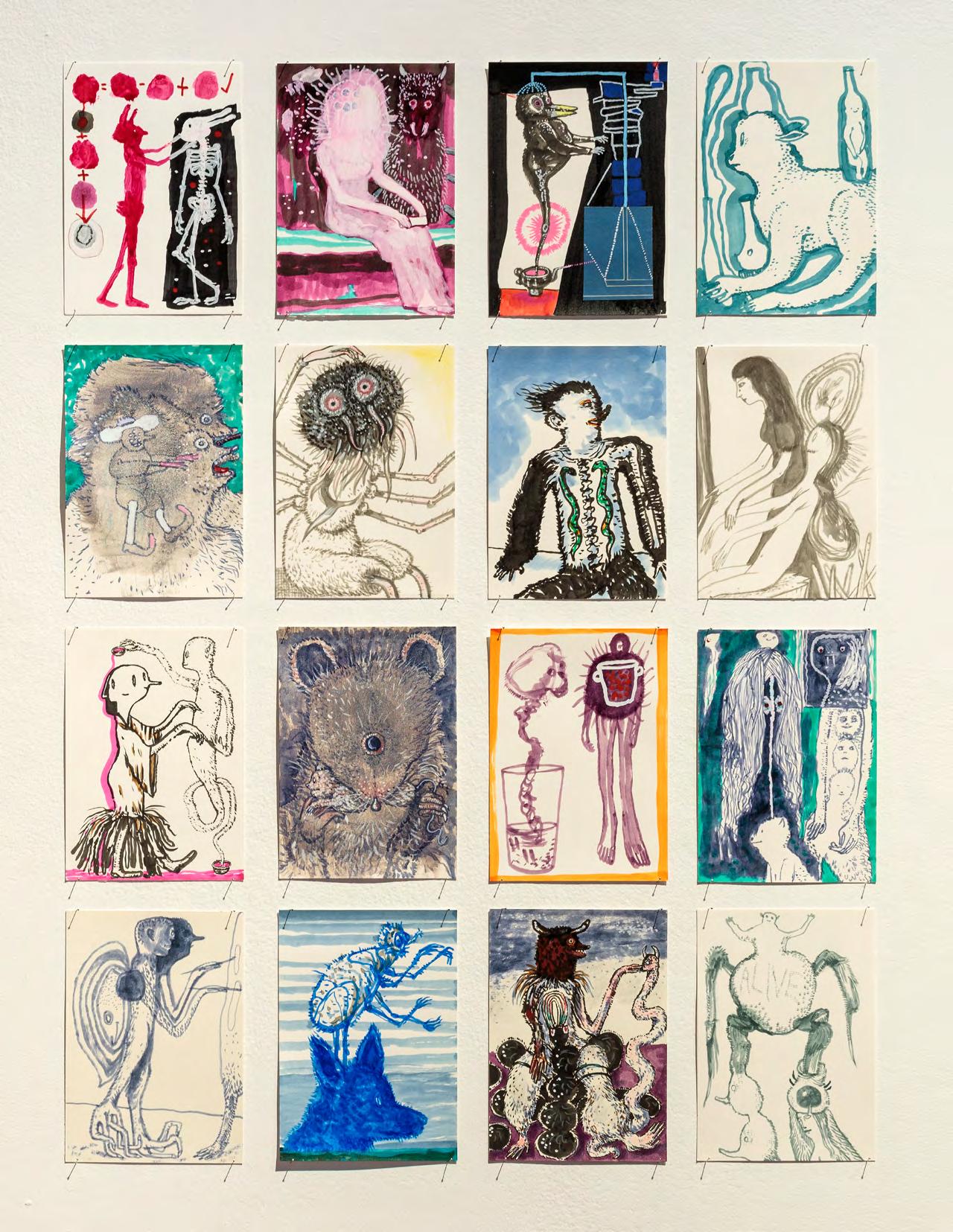
Additionally, our human relations are increasingly mediated and influenced by technology. Humans crave intimacy, yet in an era of online pornography and dating applications the search for romantic and erotic connection often begins, and ends, with a device. There are increased avenues for humans to experience the erotic via machines, such as the AI-generated pornographic fantasies in the work of Jake Elwes, or Libby Heaney’s interactive Tinderbot that communicates erotic content from the famous novel Lady Chatterley’ s Lover. However, these innovative machines fail to stand in for human connection. Holly Block’s photographic work provocatively examines how our desire to connect is being negotiated and redefined through our social media practices, which often sees us sadly becoming quantifiable, disposable, and dehumanised.
The third idea Future U considers is the extent that humans can augment and manipulate our bodies with technologies until we are no longer human. From transplants to prosthetics, robotics, biotechnology, wearable and ingestible sensors, we have an almost unquestioning reliance on science to keep us alive and help us thrive. Our bodies are fragile vessels, and we collectively rejoice at the ways our physical vulnerabilities can be supported and even transformed by technology. Amy Karle’s work explores the potential of bio-technological enhancements on the human body, and how such interventions might alter the course of our future. In Stelarc’s performance installation, the artist’s body is controlled and manipulated by a machine. Stelarc explores the human-machine interface by using robotics to bypass the limitations of his human body.
Our reliance on technology and advanced scientific knowledge has both positives and negatives, whether it aims are to prolong or assist our lives or our reproduction. Leah Heiss and Emma Luke’s wearable jewellery is a health device that is used to monitor loneliness levels in older individuals living in aged care and improve their wellbeing. Presenting a perhaps more dystopian view, Maina-Miriam Munsky’s unflinching prints of newborns in operating theatres foreshadow the contemporary concerns of commercialised reproductive technologies, while also highlighting its incredible potential.
The use of technology to circumvent previous bodily limitations raises ethical concerns. Zhuying Li’s work envisions a future where we play with ingestible computers. Although the prototype functions as a game that enables users to play with their interior body, it questions whether we should be wary of the invasiveness of technologies in our daily life. Karen Casey delves further inside our bodies, exploring existential and ethical issues raised by organ donation. While technologies have the capacity to extend life through artificial means, unequal access to these innovations prompt difficult decisions concerning the value of saving one life over another. Elsewhere, Patricia Piccinini’s sculpture depicts a possible future human, simultaneously cute and repulsive in its hyperrealist human-pig hybridity. This unfamiliar creature encourages acceptance and compassion towards new visions of the human form.
Future U offers insights into alternate possibilities for our futures. The dreams, speculations and even nightmares suggested by the artists provide a glimpse of a contradictory, messy future both Unlimited and Unruly. This is a world which exists beyond the limitations of flesh and rigid binaries. One thing is certain, the responses by artists are not Unanimous. It is up to us to welcome the complexities of this new world as we inevitably continue forward.
Peter Ellis Strange Brew (series)
2018–2021 works on paper
Page 11
It is a fundamental urge of humanity to transform our bodies, minds, and the world around us, and in turn to be captivated by tales of transformation. Paradoxically, we have always been confronted by a collective anxiety when it comes to the new possibilities and uncertainties that technology presents. How might rapid advances in artificial intelligence, automation, robotics and biotechnologies disrupt the definition of what it means to be human? The dreams, speculations and possible nightmares offered by artists provide a glimpse of a contradictory, messy future that is both unlimited and unruly. But it is also a future which embraces the possibilities of a body and a world that extends beyond our current limitations.
gallery one and four Page 13
are you ready for future possibilities?
Uncanny Valley Collective
Beautiful the World
In 2020 Uncanny Valley’s Beautiful the World won the top prize in the inaugural AI Song Contest organised by Dutch broadcaster, VPRO. The rules were simple: submit a three-minute song in the Eurovision style made partly or wholly by artificial intelligence.

Uncanny Valley’s winning song was a response to the Black Saturday bushfires and includes audio samples of koalas, kookaburras and Tasmanian devils. Although AI created the melody and lyrics, humans were responsible for the concept, production and vocals that brought the song to life. The music-tech collective actively collaborates with AI and are optimistic about the creative possibilities of this collaboration.
Uncanny Valley members include Charlton Hill, Justin Shave, Caroline Pegram, Alexandra Uitdenbogerd, Brendan Wright, Oliver Bown, Sally-Ann Williams, Antigone Foster and Ash Watson. Thanks to Julia Zemiro for her expert Eurovision insights.
Page 14

Page 15
Beautiful the World (still) 2020 software, musical instruments 3 minutes 38 seconds
Mistaken Identity

2018 3-channel digital video 1 hour 56 minutes 33 seconds
Mario Klingemann /Quasimondo
Mistaken Identity
Mario Klingemann presents three video portraits which have been created by multiple neural networks engaging in a gamelike contest—what is referred to as a generative adversarial network (GAN). The artist has used his ‘neural glitch’ technique to introduce random errors to the interpretation of the data, resulting in what could be considered as glimpses of creativity. The work continues Klingemann’s longstanding interest in training machines to display near-autonomous creative behaviour.
Mario Klingemann is represented by ONKAOS (Madrid, Spain). This project has been supported by the Goethe-Institut.

Page 17

2020 watercolour, gouache on paper
Peter Ellis
Peter Ellis’ idiosyncratic works on paper can be viewed as a gateway to collective cultural anxiety about technological disruption. His images depict biotechnological experiments gone wrong, resulting in monstrous humans, one-eyed rodents, and an alternative evolutionary pathway for giant fleas. The works continue the artist’s longstanding involvement with Surrealism, animism, and environmental concerns, while also referencing alchemy, transformation, and hybrid animal/human metamorphosis. The artist’s hand is present in the making of the works, gesturing towards a potential future in which the boundary between humans, animals and novel creatures is increasingly blurred.
Cloning Pigeons (detail)
Page 19

2020 gouache, ink on paper
2020 ink, gouache, watercolour on paper
1999 synthetic polymer emulsion, watercolour, gouache, pencil, collage on paper

 Alien Chart (Caprosna Kurkii)
Alien Chart (Caprosna Kurkii)
Page 21
Antler Replicator (detail)
Chemical Grafting (The Last Sapling) (detail)
Christian Mio Loclair
Blackberry Winter
Christian Mio Loclair is an artist who works at the interface of artistic and scientific research. Once a choreographer and dancer, his works investigate ways in which the movements of the human body can be reproduced digitally. These videos present three figures in motion that have been artificially generated using custom machine learning. Loclair provided a generative adversarial network (GAN) with a dataset of 120,000 bodily poses, but omitted contextual information such as the sequence or velocity of the movements. The GAN’s response to this dataset was to simulate an autonomously moving, expressive body, albeit an abstracted and fragmented one. The figures and their movements are unique digital choreographic interpretations of the human body.
Art Direction: Christian Mio Loclair; AI Artist: Meredith Thomas; Executive Production: Celia Bugniot; Music: Christian Losert; Design: AJ Walsh. This project has been supported by the Goethe-Institut.
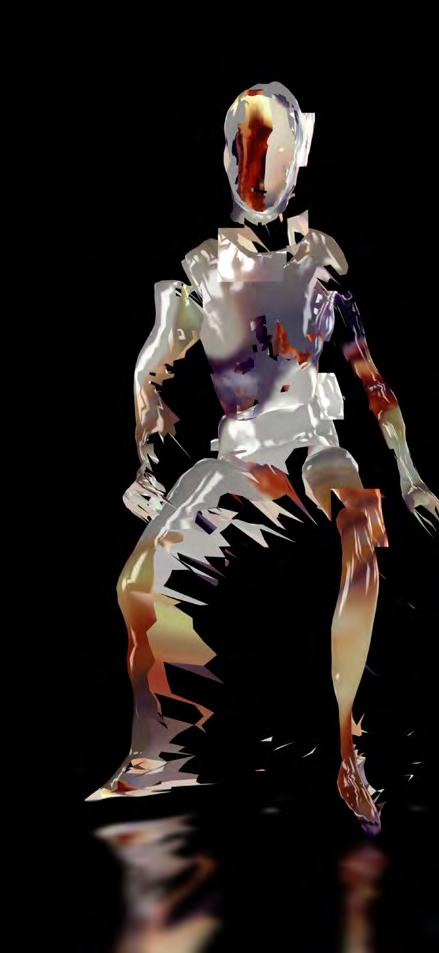
Page 22

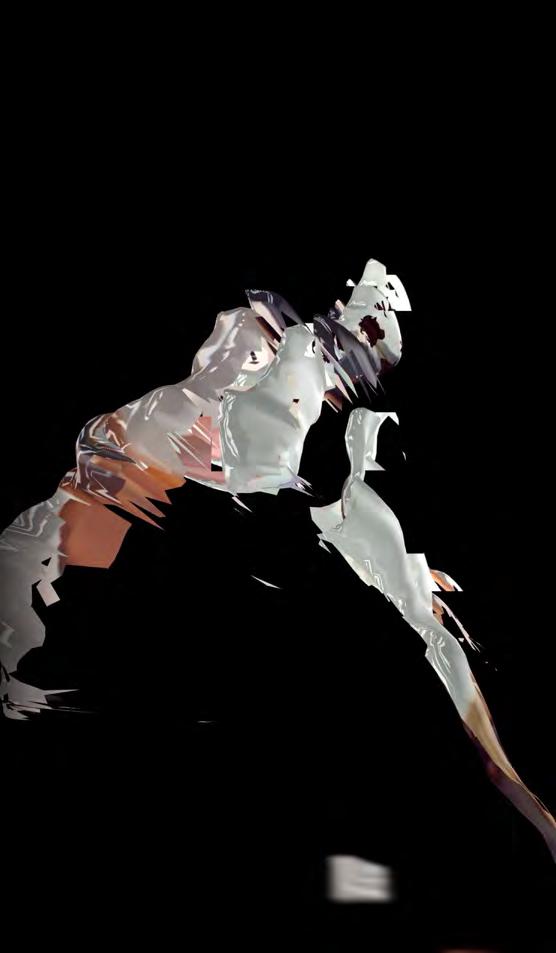
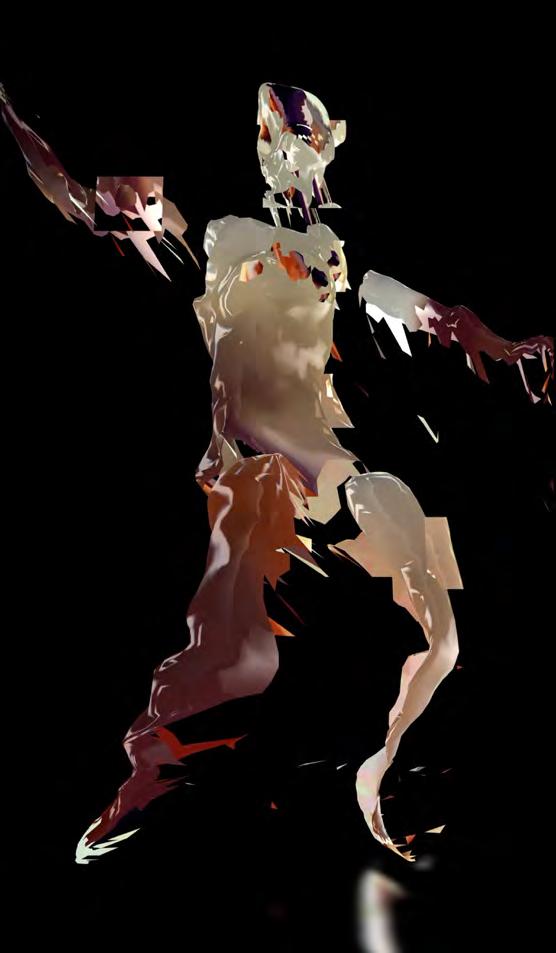
2019
10
Page 23
Blackberry Winter (still)
video
minutes

Patricia Piccinini
Teenage Metamorphosis
This futuristic sculpture depicts a possible future human, simultaneously cute and repulsive in its hyperrealist humanpig hybridity. The creature’s body lies uncomfortably under our gaze, both monstrous and provoking our empathy. It is ambiguous whether the metamorphosis referred to in the work’s title relates to the creature’s own transformation, or to the Franz Kafka novel lying next to it on the towel. In this work, Patricia Piccinini’s unfamiliar creature encourages acceptance and compassion towards new visions of the human form.
Patricia Piccinini is represented by Scott Lawrie Gallery (Auckland, New Zealand); Tolarno Galleries (Melbourne, Australia); Roslyn Oxley9 Gallery (Sydney, Australia); Hosfelt Gallery (San Francisco, United States of America).
Teenage Metamorphosis
2017 silicone, fibreglass, human hair, found objects

Page 25
Alexi Freeman
Bio Textiles
With 7.8 billion humans rapidly consuming nonrenewables, the lens through which we view natural resources urgently needs to be reframed. While textiles can be created sustainably from plant and animal materials, instead they are often produced using petrochemicals and unsustainable methods. Alexi Freeman is currently undertaking a Practice Based Research Masters at RMIT in the field of biodesign. His research aims to reduce the environmental impact of textiles, by investigating the potential of using microorganisms to create biotextiles. To produce biotextiles, nutrient rich human waste is used as food for the cultivation of a specific species of microorganism. This microorganism can secrete three-dimensional forms that self-organise into nonwoven biotextiles, presenting the possibility of a more sustainable material option for future wearables.
This research has been produced as part of a Research by Practice Masters degree at RMIT University, with the assistance of an RTP Stipend Scholarship.
Bio Textiles
2020–2021
cellulose produced by microorganisms
Page 26
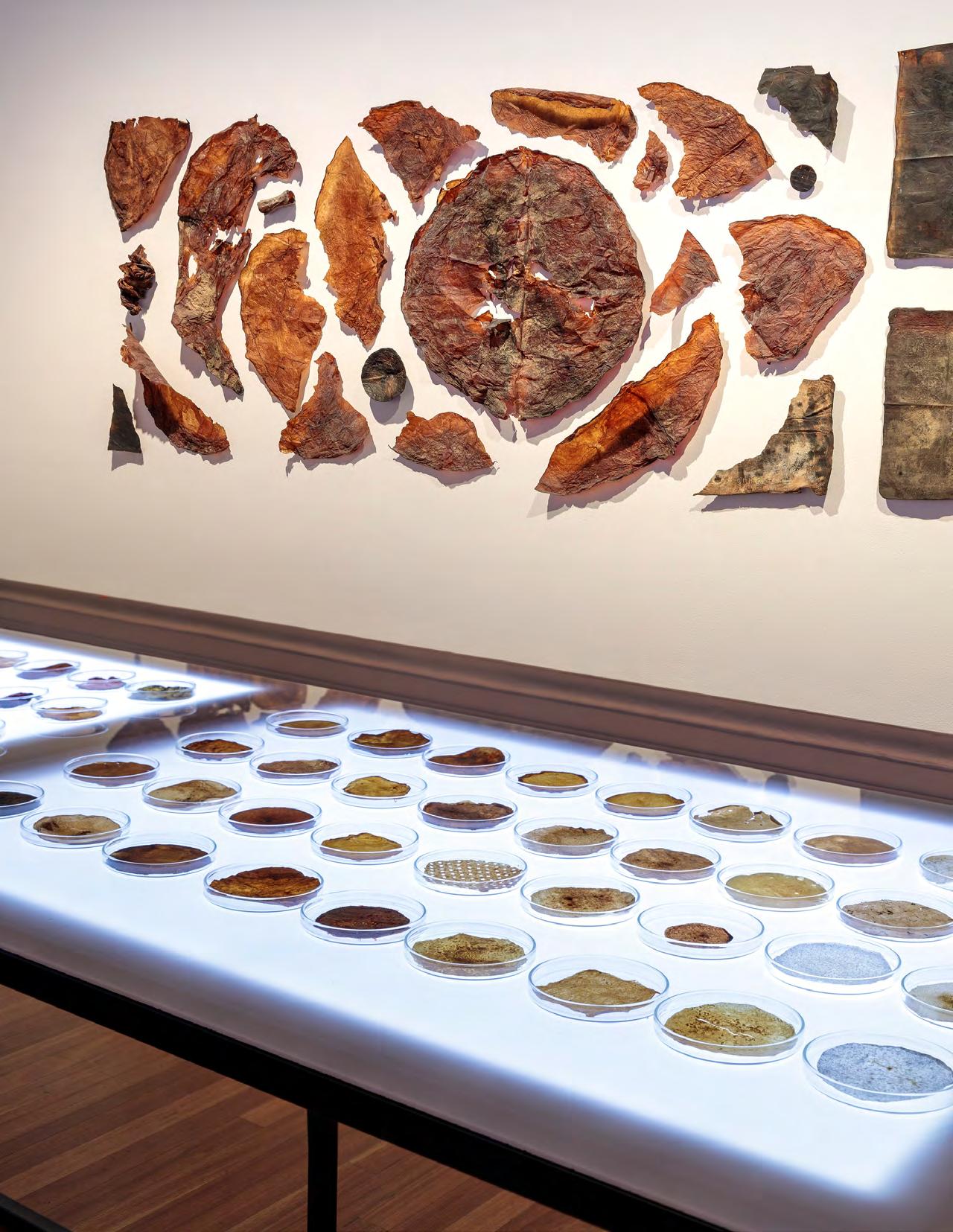
Bettina von Arnim
Artists have long explored the endless fascination we have with augmented humans, artificial lifeforms, and machines that replicate and extend our physical and creative potential. Bettina von Arnim’s prints from the 1970s examine the dehumanising effects of rapidly advancing technology. Her etchings depict an alarming fusion of human bodies and machines in an age of advanced, technology-enhanced capitalism. These prescient works from the RMIT Art Collection evoke a melancholic future, and have a chilling currency in the twenty-first century as AI, robotics and other forms of smart automation offer to bring great economic benefits but at a potentially greater human cost.
Donated by the Goethe-Institut Australien, 2010. RMIT University Art Collection, accession no: RMIT.2010.25-2010.28.

Page 28
1970 etching on heavy weave, bone, coloured paper
 Reisender III
Reisender III
Page 29

Reisender II
1970 etching on heavy weave, bone, coloured paper
Reisender IV (detail)
1970 etching on heavy weave, bone, coloured paper
Reisender I (detail)
1970 etching on heavy weave, bone, coloured paper


Page 31

Deborah Wargon TIME FOUNTAIN
TIME FOUNTAIN is a meditation on the possible trajectories of the future and the interplay between time and chance. Perceptions and ideas of time are always changing, especially as technologies develop and confront us with new possibilities and uncertainties. Wargon’s work locates itself in this speculative space between present and future. It acknowledges the possibility of many different futures and times, some of which might be available for us and others which might not.
TIME FOUNTAIN (detail)
2020 paper Page 33
Pia Interlandi

Rituals of Obsolescence
Throughout history, humans have engaged in rituals around death. Over the next decade, as technological advances begin to enable the colonisation of Mars, those rituals will need to be adapted to function on the red planet. Cut off from Earth and its resources, new systems and behaviours around death will be required. In preparation for these changes, this research project presents a possible death ritual for humans on Mars. As an aseptic planet, every organic molecule that is brought to this planet—including our own bodies—will play a vital role in sustaining life on it. This project proposes to use the process of decomposition to transform the organic matter of our bodies into nourishing soil capable of nurturing new life. On Earth, our ancestors addressed their dead through ritual. On Mars, we will continue this human ritual of dressing, wrapping, and cocooning our dead to ready them for their next transformation.
This project is part of an ongoing research collaboration between Dr. Pia Interlandi and Dr. Jayden. J. A. Hastings exploring Death Off Earth. Supported in part by the SENSORIA Program that conduct rigorous space mission simulations and test Death Off Earth prototypes.
Page 34
Rituals of Obsolescence (detail above and overleaf)
2021 silk, plaster, soil, mulberry plant, water, hydrocal, silkworm cocoons
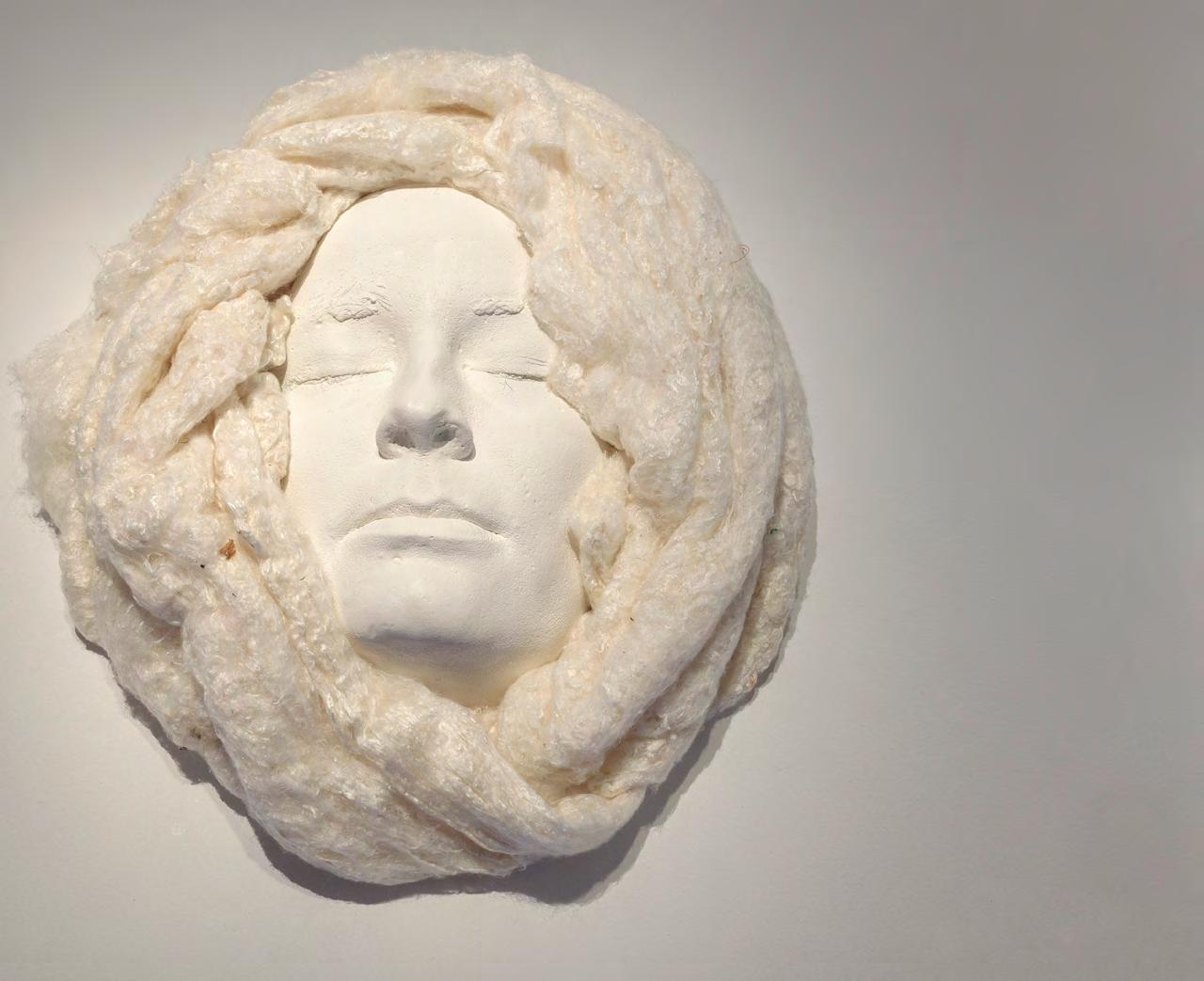
Page 35



Page 37
Duckworth Hullick Duo Disruptive Critters

At a time when artificial intelligence is on the cusp of self-awareness, Disruptive Critters provides a humorous exploration of future creativity and digital disruption. The work features the vocalised performative possibilities of computer-generated critters, each with their own human-like emotions and vocal palette of abstract utterances. The critters are autonomous co-performers seemingly striving to communicate in unpredictable ways with gallery visitors and each other alike. Further, the engagement with these critters is interactive; through the multitouch tabletop console visitors become players capable of constructing their digitally responsive and immersive critter-filled world. Players select and release critters, who quickly get up to no good, making visual and sonic mischief that ranges from being cacophonous, to being amusing or at times profoundly melodic.
Design: Jonathan Duckworth; Sound Art Design: James Hullick; Vocals: James Hullick and Justine Anderson; Software Development: Ross Eldridge and Casey Rice. Funded by the Australia Council for the Arts and Creative Victoria.
Page 38
Disruptive Critters (above and overleaf) 2018
Hardware: 42” Touch Screen, Windows PC, RME Fireface audio soundcard, 4.1 powered Audio Speakers; Software: Unity 3D, MaxMSP, 42” LCD Screen

Page 39
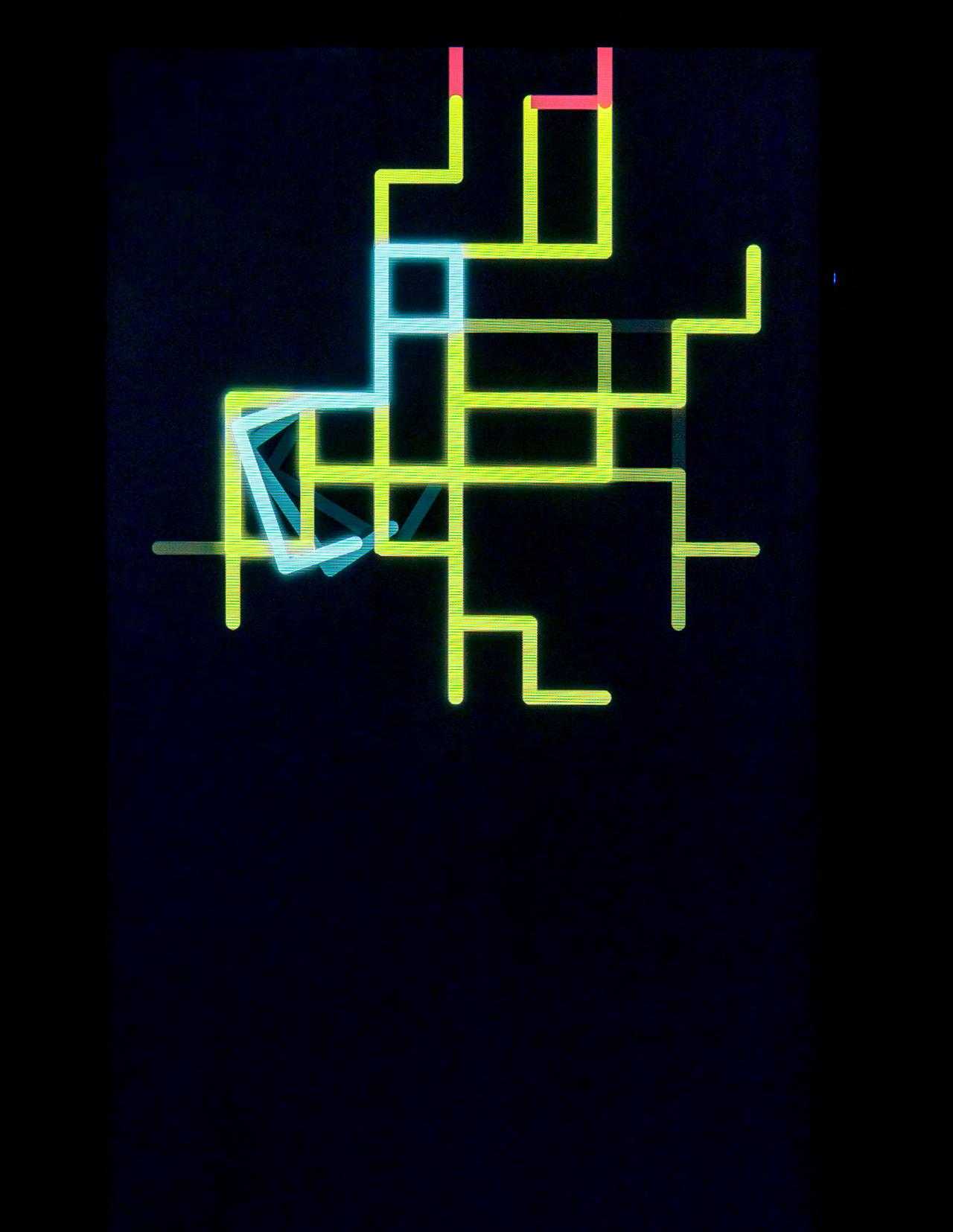

Page 41
How will sexuality and romantic love change as our interactions with each other become more entangled with technology? Humans crave intimacy, yet in an era of online pornography and dating applications the search for romantic and erotic connection often begins, and ends, with a device.
As our human relations are increasingly mediated and influenced by technology, it becomes more difficult to know which connection is real and which has been simulated or augmented. The new consumption rituals and practices of social media mean those who play the game of longing may become quantifiable, commodified, disposable, and dehumanised.
are you ready for future intimacies?
gallery four Page 43
Libby Heaney Lady Chatterley’ s Tinderbot

In this digital age, our potential romantic relationships are increasingly mediated by a mathematical matching algorithm. Online dating applications are now a common way to meet romantic partners, however these platforms often facilitate superficial relationships rather than meaningful ones. This work explores love in a world of online dating by bringing together D.H. Lawrence’s sexually explicit literary novel Lady Chatterley’s Lover and the dating application Tinder. A Tinderbot has been programmed to pose as characters from the novel as it simulates ‘chats’ with human Tinder users. Tinderbots and bots are ubiquitous in online dating apps, and gallery visitors are challenged to consider which connection is real and which has been simulated or augmented. They can follow over 800 Tinder conversations by swiping left to follow ‘negative’ conversations, and right for ‘positive’ conversations.
Produced with the kind co-operation of the Estate of Frieda Lawrence Ravagli and with thanks to Justin Long.
Page 44
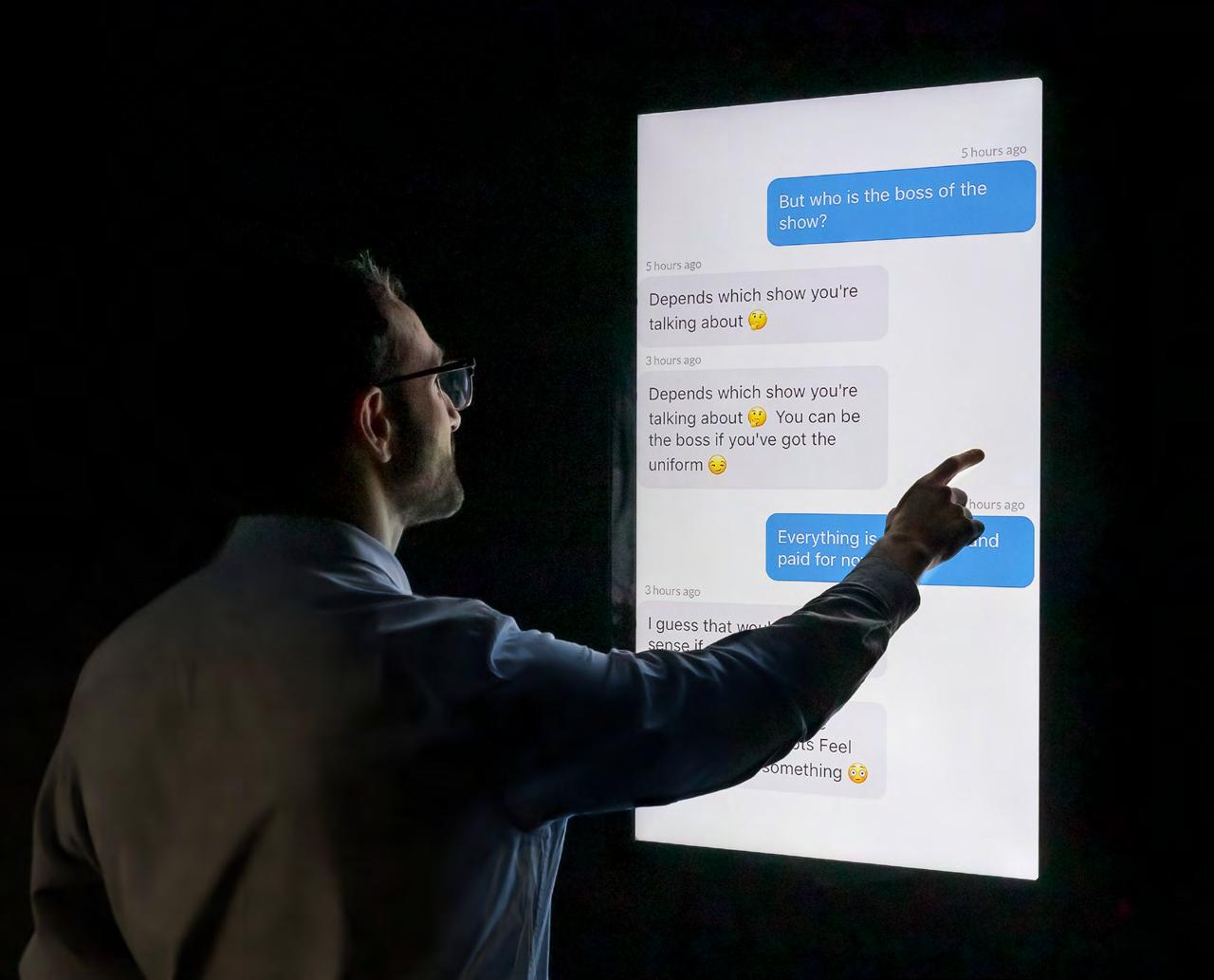 Lady Chatterley’s Tinderbot
Lady Chatterley’s Tinderbot
Page 45
2016 JPEG images, computer code, touch screen monitor

Holly Block Techno-Romance
Techno-Romance depicts a young woman in a private domestic setting who is either inserting or expelling a mobile device from her vagina. This work highlights the recent unprecedented changes in romantic and sexual behaviour and critiques mobile dating applications, such as Tinder. Further, as today’s search for intimacy and connection often begin and end with a device, this work questions and raises concerns about the evolutionary impact of these technologies. Techno-Romance explores how new media is characterised by new consumption rituals and practices, which often quantify, objectify and dehumanise the human. It attempts to ask “what aspects of sex and romantic love will we inevitably transcend as we become posthuman?"
Performer: Bronte Sommerfeld. This project has been supported by the University of Melbourne Student Union.
Techno-Romance 2018 duratran, lightbox

Page 47

Page 48
Jake Elwes Machine learning porn
Pornography is used by humans for pleasure, however in this work the pornographic fantasies have been produced by an AI. Jake Elwes trained a convolutional neural network (CNN) to identify pornography using Yahoo’s explicit content model. The CNN was then fed a dataset which included thousands of graphic images and re-engineered to generate pornography from scratch. It is more acceptable to interpret the pornographic imagery as the result of a machine using existing images to produce new scenarios. However, it is possible that we are witnessing a machine’s selfgenerated sexual fantasies, encroaching on the unique human ability to create sexualised stories for arousal.
Inspired by Gabriel Goh, the machine learning researcher who originally discovered the technique.
Machine learning porn (stills)
2016 digital
12
Page 49
video
minutes
Our bodies are fragile vessels, and we collectively rejoice at the ways our physical vulnerabilities can be supported, enhanced, and even transformed by technology. From transplants, to prosthetics, robotics, cybernetics, and biotechnology, we have an almost unquestioning reliance on science to keep us alive and help us thrive.
We augment and manipulate our bodies with technologies to the point where our humanness comes into question. While these technologies can prolong our lives, and assist us with living and reproduction, they raise ethical concerns.
are you ready for future bodies?
gallery two and three Page 51
Karen Casey
Karen Casey’s work grapples with the physical and moral dilemmas surrounding life extension through organ transplantation. The works are a personal interrogation of physical and psychological fragility, degeneration and regeneration through medical intervention. While advances in medical technology enable us to extend and support life through various artificial means, these advances prompt complex questions and require many intimate and difficult choices. These works incorporate visceral imagery created from X-rays, CAT and MRI scans of the artist’s own body and expose Casey in a state of fragility and transformation.
Audio Design & Production: Nick Livingston with Karen Casey. All works were created using Osirix DICOM medical imaging software. Project supported by the City of Melbourne Arts Grant Program. The artist also gratefully acknowledges the generosity of Osirix creators Pixmeo and the Austin Hospital and Liver Transplant Unit for their continued care and support.

Page 52
Transmutation (left) 2021, duratran, lightbox

Inner Space (middle) 2021, digital image
Transplanted (right) 2021, video
Page 53


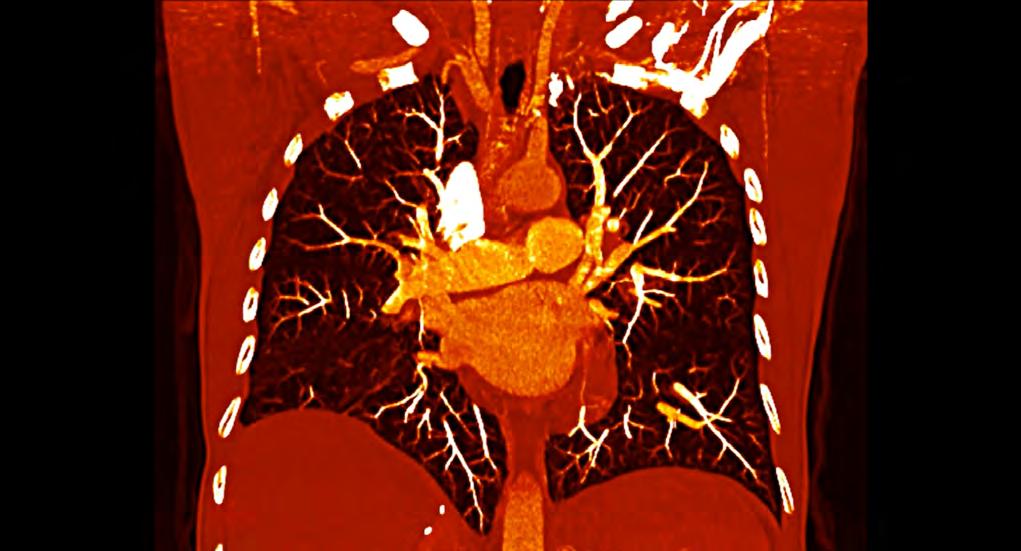
2021 duratran, lightbox 2021 video Transmutation Transplanted (stills top and above)
Amy Karle Amy Karle: Bringing Bones to Life

At a time when bio-technological body enhancements are possible, Amy Karle’s work provokes an emotional response to, and a conceptual discussion of, the implications of technology on humanity. Depicting scientific research and cutting-edge technology, this video work presents the making of Regenerative Reliquary, a BioArt sculpture of a 3D printed skeletal human hand. This sculpture is intended to be used as a scaffolding across which human stem cells can be seeded, grow into tissue and mineralise into bone.
Thank you to the collaborators who generously contributed their knowledge and talent to this project: Bio-Nano Scientist Chris Venter, and Material Scientists John Vericella and Brian Adzima. This project was made possible with the generous support of Autodesk, Autodesk’s Artist in Residence Program, Bio/Nano Research Team, the Ember 3D Printer Team, Within Medical, California Academy of Sciences, Exploratorium: The Museum of Science, Art and Human Perception, and The Bone Room. Film by Charlie Nordstrom, Blue Bergen, and Amy Karle.
Page 56

Page 57
Amy Karle: Bringing Bones to Life (still)
2016 video 4 minutes 27 seconds


Page 58
Leah Heiss and Emma Luke
CaT Pin (on page and overleaf)

2021 photograph mounted on aluminium, Pinkysil, wax, silver, electronics
The CaT Pin is a discreet, low-cost wearable to detect loneliness. In the form of a lapel pin or brooch, the device detects the presence or absence of conversation. It is founded on the premise that loneliness is manifest in a poverty of conversation, hence using the number of words spoken a day as a surrogate marker for social isolation and loneliness. It operates as a ‘nudge’ device, designed to send a text message to a loved one or care worker when the wearer drops below a baseline figure for ‘healthy’ interaction rates. The form of the CaT Pin can be customised to the style and aesthetics of the wearer by imprinting its surface with cherished jewellery, medals or textiles.
Collaborators: Matiu Bush, Glenn Matthews and Paul Beckett.
CaT Pin Page 59




Page 62
2019-2020 video, ingestible sensor

Zhuying Li InsideOut
Zhuying Li presents an alternative use of imaging capsules—medical devices that enable us to see our interior body. Imaging capsules are increasingly common in clinical settings and often used to improve the efficacy of health treatments. This work uses interactive body imaging technologies to create a playable game, whereby users swallow digital sensors that allow them to explore their internal organs and experience a different bodily awareness.
Collaborators: Yan Wang, Jacob Sheahan, Stefan Greuter, Florian ‘Floyd’ Mueller.
InsideOut
Page 63
Maina-Miriam Munsky

These works from the RMIT Art Collection reveal Maina-Miriam Munsky’s almost clinical sociopsychological representation of the technological interventions in medicine, where humans are reduced to flesh to be saved by machines. Munsky portrays an unflinching world of failing newborn bodies cocooned and kept alive by incubators, rather than by their mother’s care. Her focus on the interventions of technology and not nature in childbirth strips away romanticised depictions of the maternal ideal. In doing so, the artist foreshadows the contemporary concerns of commercialised reproductive technologies, but also highlights the potential these technologies offer women.
Donated by the Goethe-Institut Australien, 2010. RMIT University Art Collection Accession no: RMIT.2010.40, RMIT.2010.41 and RMIT.2010.42
Page 64
Unfallstation
1971 etching on heavy weave paper

Page 65


Page 67
Brutkasten 1974–76 etching on heavy weave paper 1972 etching on heavy weave paper Untitled [unknown]
Stelarc

Stelarc has interrogated the limits of his body for the past 40 years, enhancing, modifying and subjecting his flesh to various challenges, from bodily suspension to the intrusions of prosthetics, robotics, cybernetics and biotechnology. For Stelarc, the contemporary body has become a hybrid of meat, metal and code. He explores the interconnections of hybrid human-machine systems and their increasingly blurred boundaries of human agency. The artist’s installation StickMan/ miniStickMan involves Stelarc’s body being controlled and manipulated by a machine. This performative work plays out the possibility of augmenting our flesh with robotics, transcending our bodily limitations while remaining human.
Extended Arm acknowledgements: Fabrication: Jason Patterson; Pneumatic Controller: F18, Hamburg. StickMan / miniStickMan acknowedgements: Sound Design: Petros Vouris; Engineering: Tim Jewell; Programming: Steve Berrick; Audio Engineer: Alwyn Nixon-Lloyd; Technical Assistance and Video Production: Steven Alyian. Stelarc is represented by Scott Livesey Galleries (Melbourne, Australia).
Page 68
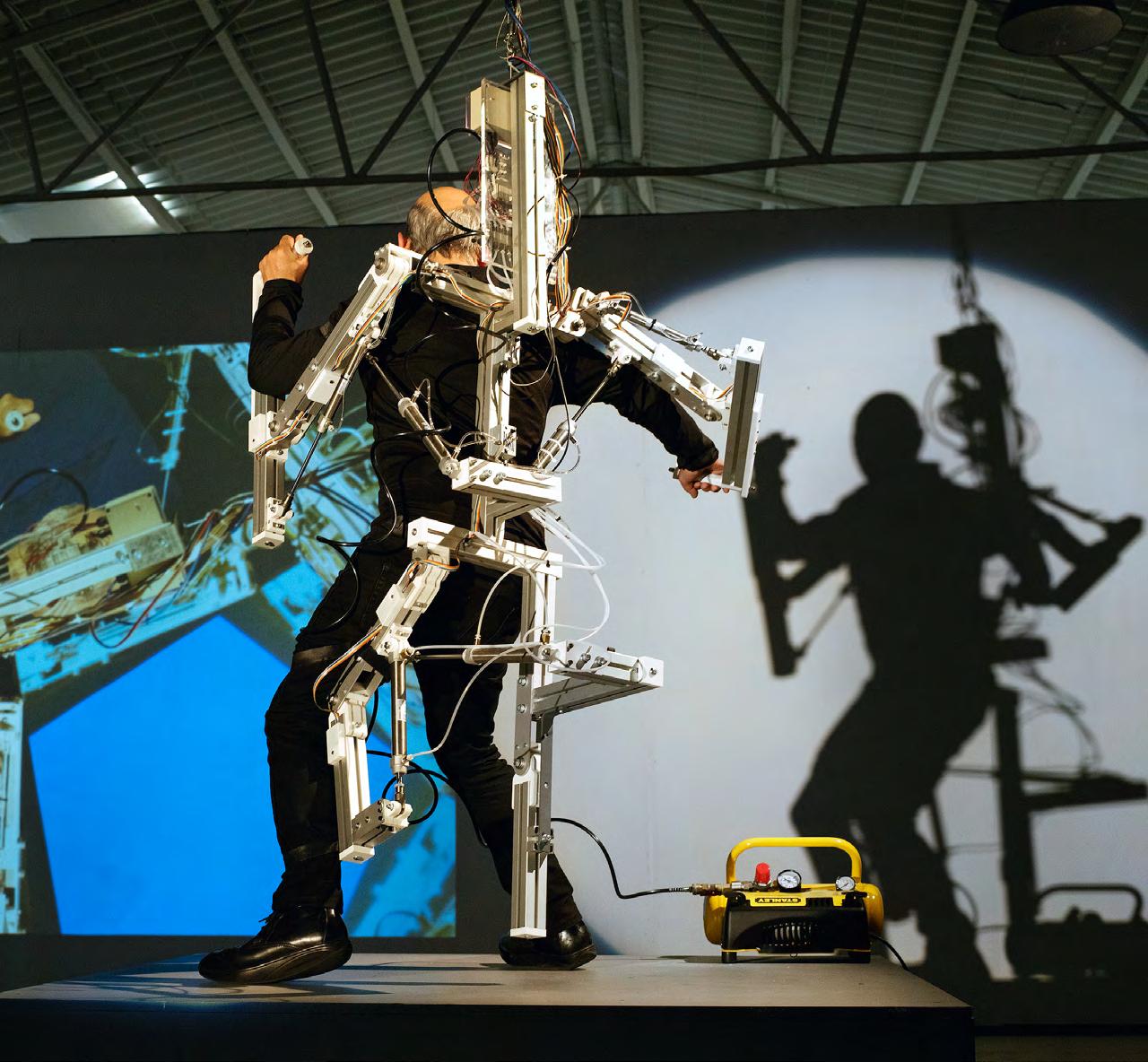
Extended Arm (overleaf) StickMan
2000 aluminium, acrylic, pneumatics, electronics 2017 aluminium, pneumatics, electronics Page 69
/ miniStickMan


biographies
Bettina von Arnim
Bettina von Arnim is a German painter, illustrator and graphic artist associated with the New Realism and German Pop art movements. She grew up in West Germany, studying at the Berlin Hochschule für Bildende Künste from 1960–1965. She studied etching technology at celebrated engraver Johnny Friedlaender’s Paris workshop during a scholarship from 1962–63. von Arnim had her first solo exhibition in 1964 in Frankfurt am Main and had gallery representation in Berlin from 1970. She was one of the founding members of the Aspekt group from 1972 (together with Ulrich Baehr, Hans-Jürgen Diehl, Maina-Miriam Munsky, Wolfgang Petrick, Peter Sorge and others), which opposed abstract styles in favour of Critical Realism. Her works are held in significant private and public collections, including the Berlinische Galerie, Berlin; Deutsche Bank, the Contemporary Art Collection of the Federal Republic of Germany; the Städel Museum, Frankfurt; and the Kunstmuseum Bonn, Germany. von Arnim has lived and worked in south-west France since 1975.
Holly Block
Holly Block’s practice encompasses video, photography, installation, and sculpture to interrogate the nature of experienced reality. Her oeuvre entangles binaries of the human and non-human, deploying reoccurring motifs of hair and hairlessness to explore notions of other and embodiment. Her work is informed by quantum physics, while her background in choreography expands into the performance of gender and identity to reveal the instability of these states. Block’s most recent work explores the impact of technology on intimacy and asks what aspects of sex and romantic love will we inevitably transcend as we become posthuman? Recent solo exhibitions have been held at MARS Gallery, Melbourne; SEVENTH Gallery, Melbourne; RMIT Gallery, Melbourne; Spring 1883, Melbourne; Praxis 5, SaRang Building, Indonesia; Moving Images, Latrobe Regional Gallery, Morwell, Victoria; George Paton Gallery, Melbourne; and Trocadero Art Space, Melbourne. Block is the recipient of the 2019 VCA ACCESS mentorship award.
Karen Casey
Karen Casey is an Australian interdisciplinary artist exploring intersections between the arts, science, and society. She is of Indigenous/Anglo-Celtic background and has exhibited widely both locally and internationally since the late 1980s, working across a broad range of media from painting to installation, public art and digital media. Her collaborations with both arts and non-arts professionals from diverse fields and backgrounds have given rise to some innovative interactive and transdisciplinary hybrid art-forms. She is the creator of the Global Mind Project, an ongoing arts and cognitive neuroscience initiative and Let’s Shake—a public art participation project for peace, reconciliation, and unity. Casey’s current work focuses on the interplay between medical technology and artistic expression. Exposing the audience to conditions and experiences that transcend physical and psychological boundaries, she challenges her audience to traverse the comfortable and familiar through her representation of trauma and her interrogation of what it means to be human.
Duckworth Hullick Duo
Jonathan Duckworth is an Associate Professor in Digital Design, School of Design at RMIT University, Melbourne, and an artist in the audio-visual Duckworth Hullick Duo. His interdisciplinary practice-based design research forges synergies between digital media art, human computer interaction, health science, and game technologies. Duckworth’s work has yielded significant innovations within the arts and health technology sector and has been recognised for design excellence as a past recipient of the Victorian Premier’s Design Award and Good Design Award in Digital Design. His creative work spans across the design of therapeutic applications within acquired brain injury rehabilitation and generated significant impact in other cultural and community sectors relevant to music creation, sonic public performance, disability, and participation in the arts in collaboration with James Hullick. Duckworth has exhibited at numerous major national and international venues for creative work including Craft ACT, Canberra; Melbourne Festival; Ars Electronica, Linz, Austria; and Sónar+D, Barcelona.
Page 72
James Hullick is a composer, musician and Artistic Director and CEO of JOLT Arts, an inclusive sonic arts organisation that presents new cutting-edge work by local and international sonic artists with a focus on sound makers across a range of contexts and abilities. Through JOLT, he has co-directed large sonic events and festivals locally and in Asia, Europe, and the US. Since 2006, Hullick has worked with The Amplified Elephants, an ensemble for artists with intellectual disabilities. His creations are concerned with questions of our collective social life drawn from his work with community artists. Hullick is an Australia Council for the Arts Creative Fellow 2015 and Michael Harvey Piano Scholar 2016. His creativity manifests sound worlds from inventive machines, electronics, acoustic instruments, found objects, the human voice, sonic ensembles, and the uncanny merging of these things.
Peter Ellis
Peter Ellis’ art practice spans more than 45 years. During this time, he has produced paintings, drawings, prints, objects, multiples, zines, sound works and artists’ books. His work explores the Surrealist conception of ‘the marvellous’, exploiting the power of the imagination and the unconscious mind through techniques such as dream analysis and psychic automatism. He has presented more than 20 solo exhibitions and his work has been selected for 177 curated group exhibitions in Australia and internationally. Ellis’s work is represented in the National Gallery of Australia, National Gallery of Victoria, Art Gallery of New South Wales, Art Gallery of Western Australia, Queensland Art Gallery | Gallery of Modern Art, 15 regional galleries, and a variety of collections across the world. He is an Associate Professor and Studio Leader of Painting at the School of Art, RMIT University, Melbourne.
Jake Elwes
Jake Elwes is a media artist living and working in London. He studied at The Slade School of Fine Art, University College London (2013–17). Recent works explore his research into machine learning and artificial intelligence. His practice looks for poetry and narrative in the success and failures of these
systems, while also investigating and questioning the code and ethics behind them. His current works in the Zizi Project explore AI bias by queering datasets with drag performers. They simultaneously demystify and subvert AI systems. Elwes has exhibited in museums and galleries internationally, including the ZKM, Karlsruhe, Germany; TANK Museum, Shanghai; Today Art Museum, Beijing; CyFest, Venice; Edinburgh Futures Institute; Zabludowicz Collection, London; Frankfurter Kunstverein, Germany; Bloomberg New Contemporaries 2017, UK; Ars Electronica, Linz, Austria; Victoria and Albert Museum, London; LABoral Centro, Gijón, Spain; Nature Morte, Delhi, India; Centre for the Future of Intelligence, Cambridge; and he has been featured on ZDF and BBC.
Alexi Freeman
Alexi Freeman is an interdisciplinary artist, fashion and textile designer currently undertaking a Practice Based Research Masters at RMIT University. Juxtaposing speculative ideas with artisanal, biological and technological methodologies, Freeman has released more than 20 critically acclaimed collections of artefacts that push the parameters of wearable design materials. Freeman has presented work at London Fashion Week; Mona Foma Festival; NGV Melbourne Design Week; stockists in New York, Moscow & Christchurch; bespoke ensembles for Kimbra, Ruby Rose and Georgia May Jagger; and a bridal commission for artist Kirsha Kaechele. He has also designed costumes for The Australian Ballet’s 50th anniversary at the Sydney Opera House; exhibited at the National Gallery of Victoria, Melbourne; the National Gallery of Australia, Canberra; and Powerhouse Museum, Sydney. Freeman launched his WHITE NOISE collection on the roof of the Museum of Old and New Art, Hobart. The designer’s future provocations include photosynthetic biodegradable active wear and evening wear that harvest energy via infrared radiation.
Page 73
Libby Heaney
Libby Heaney is an artist with a PhD in quantum physics, who makes conceptual artworks with emerging technologies like machine learning and quantum computers. The resulting videos, performances and participatory experiences question the machine’s dominant forms of categorisation and playfully propose alternatives, undoing existing biases and forging new expressions of collective identity and belonging with each other and the world. Heaney has exhibited her artwork in galleries and institutions in the UK and internationally, including solo exhibitions as part of the 2017 EU Capital of Culture, Aarhus, Denmark; and at the Goethe Institute, London, and in group shows at Etopia Centre for Art and Technology, Zaragoza, Spain; Holden Gallery, online; LUX with Hervisions, online; Arebyte Gallery, London; Tate Modern, London; ICA, London; Victoria and Albert Museum, London; Barbican, London; Somerset House, London and online; Sheffield DocFest: Sheffield International Documentary Festival, 2018; Science Gallery Dublin, Sonar+D, with the British Council, Barcelona; Ars Electronica, Linz, Austria; and Telefonica Fundacion with the British Council, Lima, Peru. She is currently a resident of Somerset House Studios, London.
Leah Heiss and Emma Luke
Associate Professor Leah Heiss is an award-winning designer, CSIRO visiting designer/scientist and the Eva and Marc Besen International Research Chair in Design at Monash University. Through collaborative projects Leah has brought human-centred design to technologies for hearing loss, diabetes and pre-diabetes, cardiovascular disease, gut disease, and loneliness. Her wearable technologies include jewellery to administer insulin, cardiac monitoring jewellery, swallowable devices to detect disease, and emergency jewellery for times of medical crisis. Her current work investigates the use of stretchable sensors for heart health, pre-diabetes, and aged care COVID monitoring.
Emma Luke is a designer and researcher currently completing a PhD focused on aesthetics and wearable technology. Passionate about elegant interventions that challenge digital obsolescence and the loss of lasting cultural narratives, Emma has an extensive design background traversing watches, bags, jewellery and wearables. She is currently involved in a series of multifaceted wearable technology projects, focused on intuitive IOT interventions for health and wellbeing.
Amy Karle
Amy Karle is an internationally award-winning bioartist whose work can be seen as artifacts of a speculative future when digital, physical and biological systems merge. Her work opens future visions of how technology could be used to support and enhance humanity, while making advancements towards those goals in the process. Karle has exhibited worldwide including at Ars Electronica, Linz, Austria; the Pompidou Centre, Paris; Media Arts Biennale, Beijing; the Mori Museum, Tokyo; the Smithsonian, Washington; and has previously spoken at the Future Innovators Summit, Linz, Austria; among other expert speaking engagements. Karle was honoured as one of BBC’s ‘100 Women’; has been named one of the ‘Most Influential Women in 3D Printing’, and was Grand Prize Winner of the YouFab Global Creative Award. Karle was also an Artist Diplomat through the U.S. Department of State tasked with women’s empowerment and supporting collaborations using art and technology to address social issues.
Libby Heaney Lady Chatterley’s Tinderbot
2016
JPEG images, computer code, touch screen monitor
Page 74

Pia Interlandi
Dr Pia Interlandi is a designer and Senior Lecturer in the School of Fashion and Textiles at RMIT University. Her teaching and research explore the materials and materiality of death, dying, disposal, and dispersion. From fashion to forensics, her creative practice Garments for the Grave has been commissioned nationally and internationally to demonstrate contemporary approaches to touching, dressing, and addressing the dead body. Interlandi is called upon for specialist body care and ritual facilitation by professionals in the funeral industry and has personally dressed more than 150 people. She combines tacit and explicit knowledge bases to traverse and interlace academic and professional practice. Interlandi is one of Australia’s leading advocates for natural death and contemporary funeral practice. She is a founding member of the Order of the Good Death, California; Natural Death Advocacy Network, Australian Home Funeral Alliance, and the Australian Death Studies Society.
Mario Klingemann
Mario Klingemann is an artist who uses algorithms and artificial intelligence to create and investigate systems. He is interested in human perception of art and creativity, researching methods in which machines can augment or emulate these processes. His artistic research spans a wide range of areas like cybernetic aesthetics, information theory, feedback loops, pattern recognition, emergent behaviours, neural networks, cultural data, or storytelling. Klingemann won the Lumen Prize Gold Award in 2018; he received an honorary mention at the Prix Ars Electronica in 2020, and won the British Library Labs Creative Award in 2015. He was artist in residence at the Google Arts & Culture Lab and has been recognised as a pioneer in the field of AI art. His work is featured in art publications, as well as academic research, and has been exhibited at Ars Electronica, Linz, Austria; the Pompidou Centre, Paris; ZKM, Karlsruhe, Germany; the Barbican, London; the State Hermitage Museum, St Petersburg; Seoul Mediacity Biennale; the British Library, London; and MoMA, New York.
Zhuying Li
Zhuying Li completed her Doctorate at the Exertion Games Lab, Monash University, Melbourne. Her research focuses on the intersection of technology, the human body, and play, exploring how augmented-human technology can change people’s daily experiences. She is currently working on playful interaction design with ingestible sensors. Before starting her PhD, Zhuying studied Information Engineering at Southeast University, Nanjing, Beijing; and worked as a game designer at NetEase, where she helped develop the system design and plot design of a Multi-player Online RPG Game.
Christian Mio Loclair
Christian Mio Loclair is a German artist who works at the interface of artistic and scientific research. Using custom algorithms, data, and digital devices, he creates sculptures, video works and installations that portray the aesthetics and frictions of both human and digital identity. Loclair explores the contrast between natural phenomenon and data-driven algorithms. His works examine the creative and societal potential of artificial intelligence and reflects on the supposedly opposing myth of man and machine. Loclair’s practice draws upon his experience as a computer scientist, visual artist, choreographer, and dancer. He studied computer science at the University of Potsdam, Brandenburg and at the Hasso Plattner Institute, Berlin, specialising in media technology and human-computer interaction. Loclair’s approach is always a mediating one, which matches his public lectures, including contributions to Goldsmith University, London; the Pompidou Centre, Paris; re:publica, Berlin; United Nations, Geneva; and Hong Kong Performing Arts Festival. His works have been presented at the Today Art Museum, Beijing; Ars Electronica, Linz, Austria; Ming Contemporary Art Museum, Shanghai; the Pompidou Centre, Paris; and Design Museum, London. Mio Loclair lives and works in Berlin.
Page 76
Maina-Miriam Munsky
Maina-Miriam Munsky was a German New Realist artist who was based in Berlin. She studied with the artist Peter Voight at the Braunschweig University of Art, continued her studies at the Fine Arts Academy in Florence, and Berlin University of the Arts. Munsky had her first solo exhibition in 1968. In 1970 she became a member of the German Artists Association. Munsky came to prominence in West Berlin during the 1970s with a series of artworks depicting births, abortions and surgical procedures executed in a clinical style.
Patricia Piccinini
Patricia Piccinini’s international career is long and varied. With over 40 major solo shows in the last decade alone, she has shown work in Australia, New Zealand, Turkey, Canada, USA, Slovenia, Brazil, Taiwan, Ireland, UK, Korea, Spain, Japan, Peru, the Philippines, Finland and Denmark. Her 2016 touring show in Brazil was seen by over 1 million people—making it one of the most popular exhibitions in the world according to The Art Newspaper. Patricia was chosen to represent Australia in the Australian Pavilion at the 50th Venice Biennale.
Stelarc
Stelarc is a performance artist who has visually probed and acoustically amplified his body. He has made three films of the inside of his body. Between 1976-1988 he completed 26 body suspension performances from hooks into his skin. He has used medical instruments, prosthetics, robotics, Virtual Reality systems, the Internet and biotechnology to engineer intimate and involuntary interfaces with the body. He explores Alternate Anatomical Architectures with augmented and extended body constructs. He is presently a Distinguished Research Fellow in the School of Design and Art, Curtin University, Perth. Stelarc’s artwork is represented by the Scott Livesey Galleries in Melbourne.
Uncanny Valley
Co-founded by international music producer Justin Shave and acclaimed songwriter Charlton Hill, musictech collective Uncanny Valley bring together music, artists, and emerging technologies. They assist artists, labels, major brands, agencies, and broadcast networks to deliver their unique sound and tell stories in progressive ways. Most recently, Uncanny Valley won the Eurovision inspired, global AI Song Contest with academic partners from University of New South Wales and RMIT University, showcasing their interest and achievements in the field of AI-generated music. Their collaborators include producer and strategist Caroline Pegram; data scientist Dr Brendan Wright; creative technology researcher and sound producer Dr Oliver Brown; Dr Alexandra Uitdenbogerd, an expert in music information retrieval, algorithmic choral composition and sonification; Sally-Ann Williams, the CEO of Cicada, Australia’s National Centre for Innovation; and prominent French musician, Antigone.
Deborah Wargon
Deborah Wargon holds a Diploma in Music with a major in violin from the Victorian College of the Arts, Melbourne, and a Master of Arts in Scenography from Central Saint Martins College of Art and Design, London, and Hogeschool voor de Kunsten, Utrecht. Alongside her music compositions for theatre and film, Wargon has consistently engaged in a visual arts practice and over the years her works have been shown in solo and group exhibitions in Austria, Canada, England, France, Germany, Holland, Israel, Italy, Turkey, Ukraine and the USA. Her work is held in the DeKaBank Kunstsammlung des 21. Jahrhunderts, Frankfurt; The Jewish Museum, Berlin; as well as in private collections.
Page 77

Page 78
Exhibition staff:
Manager Creative Production
Helen Rayment
Strategic Planning Manager
Verity Hayward
Senior Curator
Andrew Tetzlaff
Exhibition Officers
Alice Mathieu and Vivian Cooper
Curatorial Assistant Michaela Bear Production Coordinator
Erik North
Production Officer
Tim McLeod
Production Assistants
Robert Bridgewater, Robert Jordan, Simon Maisch, Pat Mooney, Jonty Ransome, Ari Sharp and Bryden Williams
This publication has been published on the occasion of the exhibition Future U, curated by Associate Professor Jonathan Duckworth and Dr Evelyn Tsitas. Future U is an RMIT Gallery project and a part of the RMIT Culture program which occurred from 23 July to 23 October 2021.
RMIT Gallery would like to acknowledge the support the Goethe-Institut Australien, with special thanks to Director Sonja Griegoschewski and Cultural Program Coordinator Gabriele Urban.
The curators would like to thank RMIT Gallery for the opportunity to present this project, as well as the participating artists, designers and researchers for their involvement and commitment. They would also like to acknowledge the support and commitment of RMIT Culture and the RMIT Gallery team, and the generosity and enthusiasm of our project sponsors and supporters, in particular the Goethe Institut Australien’s ongoing dedication to the project. Finally, they would like to extend thanks to Professor Tim Marshall, PVC DSC and Paula Toal, Head, Cultural and Public Engagement.
Published August 2021
Design by Nick Mau of MAUHAUS. Photography of CaT Pin at the bottom of page 58 by Narelle Portanier. Photography of StickMan / miniStickMan on page 69 by Toni Wilkinson. All other photography by Mark Ashkanasy. All images courtesy the artists and their representatives.
This catalogue is copyright. Apart from fair dealings for the purpose of research, criticism or review as permitted under the Copyright Act 1968. No part may be reproduced, stored in a retrievable system or transmitted by any means, without the prior permission of the publisher.
RMIT Gallery
RMIT University 344 Swanston Street, Melbourne, Victoria 3000, Australia Web: www.rmitgallery.com Tel: +61 3 9925 1717 Email: rmit.gallery@rmit.edu.au
RMIT University acknowledges the people of the Woi wurrung and Boon wurrung language groups of the eastern Kulin Nations on whose unceded lands we conduct the business of the University. RMIT University respectfully acknowledges their Ancestors and Elders, past and present. RMIT also acknowledges the Traditional Custodians and their Ancestors of the lands and waters across Australia where we conduct our business.
Page 79













 Alien Chart (Caprosna Kurkii)
Alien Chart (Caprosna Kurkii)








 Reisender III
Reisender III














 Lady Chatterley’s Tinderbot
Lady Chatterley’s Tinderbot



























